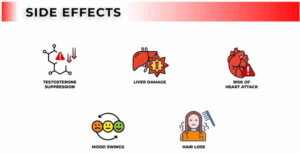In the world of performance optimization, shortcuts always seem to be there to tempt us. Whether it’s shaving seconds off your 40-yard sprint, adding five pounds to your deadlift, or chasing the ever-elusive six-pack, athletes are constantly being lured with promises of faster and better results. Lately, one particular acronym has taken center stage in that conversation: SARMs – Selective Androgen Receptor Modulators.
Scroll through TikTok or fitness Reddit and you’ll see the chatter: guys throwing around names like Ostarine, RAD-140, and Ligandrol like they’re whey protein. “SARMs Goblins,” as they’re jokingly called, are on the rise – younger athletes using these compounds to fast-track gains without doing the real work or even really understanding the cost.
But here’s the thing: SARMs aren’t magic, and they sure as hell aren’t free of side effects.
If you’re an athlete – whether you’re training for a jiu-jitsu tournament, training for a marathon, or just trying to dominate your local CrossFit box – you need to know what SARMs actually are, how they work, and why the hype might be louder than the results.
What Exactly Are SARMs?
SARMs are synthetic compounds designed to bind to androgen receptors in your body, specifically in muscle and bone tissue. Think of them as the “smart bombs” of performance enhancers. Unlike anabolic steroids, which hit every tissue in your body (including places you don’t want – like your prostate, hairline, and voice box), SARMs aim to target just muscle and bone.
This tissue selectivity is the selling point. In theory, SARMs offer steroid-like muscle gains without the “roid rage,” hair loss, or testicular shrinkage. But theory doesn’t always hold up in the real world.
The Science: Why SARMs Can Work
SARMs work by stimulating protein synthesis, the same way testosterone or anabolic steroids do. This leads to increased lean muscle mass, better recovery, and improved strength.
Common SARMs include:
- Ostarine (MK-2866) – Often used during cutting cycles for preserving muscle mass.
- Ligandrol (LGD-4033) – Known for its strong bulking effects.
- RAD-140 (Testolone) – Popular for its strength-enhancing properties.

Each of these has a slightly different profile, but the common denominator is their ability to activate muscle growth through selective androgen receptor targeting.
SARMs Aren’t Steroids, But They’re Not Harmless Either
Let’s be real: SARMs work. Plenty of athletes have packed on noticeable muscle and made strength gains using them. But SARMs are not a free lunch. In fact, many of the side effects people try to dodge by choosing SARMs over steroids still show up, just in different flavors.
We’re talking:
- Hormonal suppression – Even though SARMs don’t convert to DHT or estrogen, they can still signal your body to shut down natural testosterone production.
- Liver toxicity – Some SARMs are hepatotoxic, especially when taken orally and in higher doses.
- Mood changes – Increased aggression, irritability, and low libido have all been reported.
- Hair loss and acne – Yep, all still on the table.

And let’s not forget: SARMs are not FDA-approved for human use. They’re often sold as “research chemicals” with shady sourcing, unregulated dosages, and zero quality control.
That’s not the kind of gamble any serious athlete should be taking with their body or career.
Misunderstood Data, Misled Expectations
A lot of the confusion around SARMs comes from how they’re presented in studies or online discussions. Here’s the deal:
Not All SARMs Are Created Equal
Just because two compounds fall under the “SARM” label doesn’t mean they have similar effects. For example, one SARM might have a muscle-to-androgenic effect ratio of 500:1 (super selective), while another sits at 4:1 (far less selective). That’s a massive difference.
Testosterone Is a Flawed Benchmark
Many studies compare SARMs to testosterone to prove they’re “better.” But testosterone itself is non-selective, breaking down into more potent androgens like DHT. Comparing SARMs to a hormone notorious for side effects doesn’t mean SARMs are safe; it just means they’re less bad in some contexts.
Stacking Hype on Hope
Fitness influencers love SARMs because they sell the dream: fast results, no sides, no PCT (post-cycle therapy). But the science and anecdotal user reports paint a murkier picture. Gains – especially chemically manufactured ones – come with tradeoffs. Period.
The Real Risk of The “SARMs Goblin” Mindset
One of the biggest red flags isn’t just the compounds – it’s the culture developing around them. Teenage gym rats are hopping on RAD-140 before they’ve even learned to squat properly. Weekend warriors are chasing shortcuts instead of dialing in sleep, nutrition, and training.
developing around them. Teenage gym rats are hopping on RAD-140 before they’ve even learned to squat properly. Weekend warriors are chasing shortcuts instead of dialing in sleep, nutrition, and training.
The biggest danger? SARMs becoming the new baseline – not a calculated risk for elite lifters or rehab patients, but the default move for anyone who wants to look good on Instagram.
That’s not performance – that’s delusion.
The Athletic Cost
For competitive athletes, the consequences of SARMs go beyond health:
- Drug Testing – SARMs are banned by most major sports organizations, including WADA. Even trace amounts from contaminated supplements can trigger a positive test.
- Inconsistent Potency – Because SARMs are unregulated, you may not be getting what the label says. A “10mg” RAD-140 dose could be underdosed or spiked with prohormones.
- Recovery Debt – While SARMs can speed up short-term progress, the long-term crash post-cycle. especially without a proper PCT, can derail months of training.
Where SARMs Might Have a Place
It’s not all doom and gloom blanket statements here. There’s ongoing research into SARMs for legitimate medical use – treating muscle-wasting conditions like cachexia or sarcopenia, and potentially helping elderly patients preserve bone density.
In elite circles, under the supervision of medical professionals, SARMs might offer a calculated edge in certain rehab or transitional training phases.
But for the average gymgoer or weekend warrior? That’s probably not a lane you need to be in. And if you’re a serious athlete with a long-term game plan and reputation, SARMs probably aren’t worth the detour.
Bottom Line: Are SARMs Worth It?
If you’re considering SARMs, ask yourself:
- Have I mastered training, recovery, and nutrition?
- Am I willing to risk hormonal suppression, liver stress, and maybe even legal consequences for short-term gains?
- Do I actually know what I’m putting in my body – and what’s backing that information?
SARMs are a powerful tool. But like all powerful tools, they come with a cost. For most athletes, that cost outweighs the reward.
If you’re in this for the long haul – for performance that’s real, resilient, and repeatable – focus on the basics first. Strength. Sleep. Fuel. Consistency. And maybe a bit less TikTok bro-science.
Train smart. Stay clean. Play the long game.







